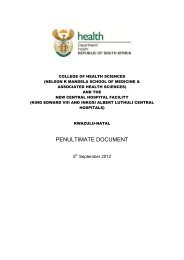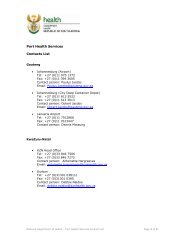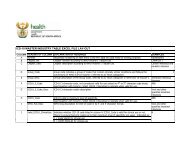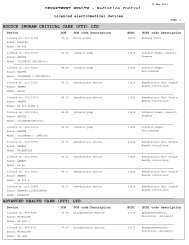National Norms and Standards relating to Environmental Health
National Norms and Standards relating to Environmental Health
National Norms and Standards relating to Environmental Health
You also want an ePaper? Increase the reach of your titles
YUMPU automatically turns print PDFs into web optimized ePapers that Google loves.
water world etc)1. In the event of non-compliance with water quality st<strong>and</strong>ards, sampling frequency must be increased(for example <strong>to</strong> 4 samples per month). The microbiological quality of water is usually sampled at ahigher frequency than the chemical quality of the water.2. The recommended frequency of sampling must be adhered <strong>to</strong>, <strong>to</strong> ensure optimal number of samplesthat will provide reliable results. A low frequency of samples will not reflect the correct variations inwater quality changes at a specific site <strong>and</strong> <strong>to</strong>o high frequencies will result in wastage onunnecessary sampling <strong>and</strong> analyses.3. Water should be moni<strong>to</strong>red in the distribution system <strong>and</strong> in the reticulation network on a monthlybasis as part of compliance moni<strong>to</strong>ring <strong>and</strong> a risk management system <strong>to</strong> identify high risk areas.4. Where communities are still dependent on unimproved water sources EH must ensure that surfacewater moni<strong>to</strong>ring (e.g. rivers, streams, <strong>and</strong> springs) is included in the water quality moni<strong>to</strong>ringprogrammes <strong>and</strong> timeous health related interventions are provided.5. Moni<strong>to</strong>ring of unimproved water sources should be accompanied by the necessary communityeducation <strong>and</strong> the encouragement of WSAs <strong>to</strong> extend coverage <strong>to</strong> high risk areas where communitiesare mainly dependent on these water sources.6. Community- Based organizations (CBOs) <strong>and</strong> other NON-Governmental Organizations (NGOs)should be trained on household water management (household water treatment, Oral Rehydration,good household <strong>and</strong> environmental practices etc.) as trainers of their own communities <strong>to</strong> ensuresustainability in community education.7. EHPs must assess the information provided by such organizations <strong>to</strong> ensure that it is similar, reliable<strong>and</strong> valid.8. Regular area surveys must be conducted <strong>to</strong> moni<strong>to</strong>r progress in coverage of communities with safewater supply systems.9. Records of daily samples at water treatment works (turbidity, PH) should be made available <strong>to</strong> EHPsfor assessment, on request.10. To moni<strong>to</strong>r the quality of water that the community accesses, water must be sampled from thetaps/collection points. Where any non-compliance is identified, EHPs must conduct follow upsampling as part of the risk management approach in order <strong>to</strong> ensure compliance within a reasonabletime, <strong>and</strong> in case of compliance, relevant feedback is necessary.11. In the case of non-compliance <strong>and</strong> where the quality of water cannot be controlled in a sustainableway through the water reticulation system within a reasonable time, emergency measures must beinstituted as prescribed in the WSAs Water Safety Plan.WATER SAMPLING REQUIREMENTSa) Planning for sampling1. EHPs must plan for water sampling before conducting the sampling.2. Planning for sampling should:• Identifying the labora<strong>to</strong>ry intended <strong>to</strong> be used for the analysis of the samples;• Communication with the labora<strong>to</strong>ry <strong>and</strong> making inquiries on specific requirements (e.g. businesstimes, sampling scope of analysis for the labora<strong>to</strong>ry (e.g. bacteriological/ chemical/ physicalanalysis), <strong>and</strong> equipment requirements e.g. sampling bottle types;• Include ensuring availability of transport <strong>to</strong> deliver the samples <strong>to</strong> the labora<strong>to</strong>ry;• Specifics on the period (date, month an year) in which samples will be taken; <strong>and</strong>3. Water samples should be planned in such a way that it include various seasons <strong>to</strong> evaluate variationin terms of water sources contamination or the status of water quality.4. It is vital that EHPs should plan for sampling <strong>to</strong>gether with the labora<strong>to</strong>ry intended <strong>to</strong> be used <strong>to</strong>ensure the capacity of the labora<strong>to</strong>ry <strong>to</strong> analyse the samples <strong>and</strong> provide the results within areasonable time.b) Sampling equipmentDOH. <strong>Norms</strong> <strong>and</strong> st<strong>and</strong>ards for environmental health in South Africa Feb 2013 97



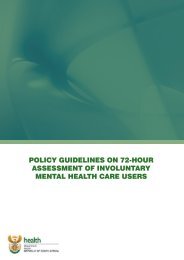
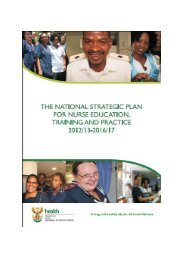
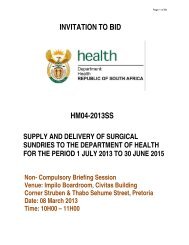
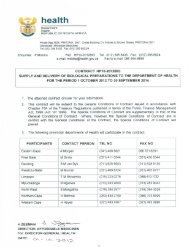
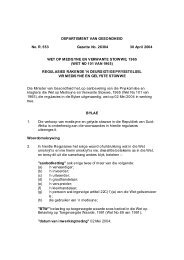
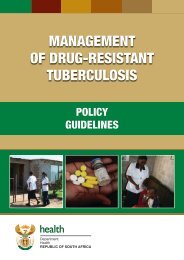
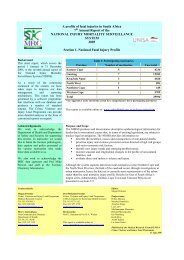
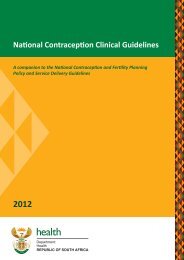
![A monograph of the management of postpartum haemorrhage [2011]](https://img.yumpu.com/15578784/1/184x260/a-monograph-of-the-management-of-postpartum-haemorrhage-2011.jpg?quality=85)
